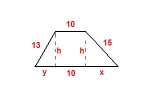Hi Engineer:
I was hoping that you would answer the question in my first response. (The same question appears in red below.)
?
Fl Engineer said:
I should have emphasised more that legs a and b are unknown, and the hypotenuse is an integer multiple of a primitive Triple.
Emphasis was not needed; clarification was. Your statement above (in blue) is not correctly worded. It does not make sense.
A hypotenuse is a length. We can certainly say that a given hypotenuse is an integer multiple of some other length, but a primitive Pythagorean triple is not another length; it's a set of three integers.
c = hypotenuse in your original triangle abc
C = hypotenuse in some other triangle that is a primitive Pythagorean triple
k = an integer
c = k*C
? Is this what you're trying to say?
?
Fl Engineer said:
Find area of trapezoid:
base 1 = 24, base 2 = 10, legs of length 13 and 15. No angles given.
My first look, I immediately recognized the 15 as the hypotenuse of a 3 multiple of a 3,4,5 triple. Used that as a check, and it worked.
Your usage above with both pronouns "that" and "it" is ambiguous. I would need to see your steps, to be confident that I understand this "check".
15 is
not a "3 multiple of 3,4,5".
15 is a "3 multiple of 5".
Okay. Perhaps this is enough to confirm that your answer to my question in red is "yes", but I still only have partial confidence that I know what you're thinking. I understand how you could form a right triangle in the trapezoid, using the 15-unit side as the hypotenuse. I understand how you could interpret this right triangle as an enlargement of the primitive triple 3-4-5. I understand how you could thus conclude that the legs on the right-triangle with hypotenuse 15 have measure 9 and 12.
But I do not understand how you concluded that this right triangle (with hypotenuse 15) is oriented such that the 9-unit leg is a section of the trapezoid's 24-unit base — versus the 9-unit leg being the trapezoid altitude — because there are two possibilities.
If you don't understand what I just wrote, please let me know, and I will upload some labeled diagrams to illustrate what I mean.
?
Fl Engineer said:
I did a few calcs to try and find a counterexample, but couldn't. I also tried to find another method of solving the problem without using the Pythagorean Triple recognition. I couldn't come up with a solution that didn't involve 2 or more variables.
You won't be able to find an example of some enlarged primitive-Pythagorean-triple triangle, where the enlargment has an integer hypotenuse, whose sides are not all corresponding integer multiples because triangle sides increase proportionately and the set of Integers is closed under multiplication.
The method that I used to find the area of your trapezoid involves three variables; does it matter? There's many ways to skin this cat!
(I don't know in which course your daughter is currently enrolled, and I obviously don't know her math background and skills, but I used an
algebraic approach to find the trapezoid's altitude, followed by applying a standard formula for the area of a trapezoid in terms of the base lengths and altitude.)
?
Fl Engineer said:
I'm just curious if anyone thinks that as a general rule, I can tell her that it is at least highly likely that when dealing with lengths that are integers, a Pythagorean Triple multiple recognized in a right triangle, should at least be checked as a first possibility.
Sure, you can tell her that. Any time we can break an object into sub-pieces, and one of those pieces is a right triangle with a hypotenuse that's an integer multiple of another hypotenuse in some primitive triple, we know that the legs on this sub-piece are integer mutliples of the legs in the triple. Always!
But, one needs sufficient information to know how such a primitive-triple-multiple is oriented, in the exercise at hand, because there are two possibilities for the legs.
Keep your questions coming, if you like. Especially if I wrote anything that you do not understand.
I'm happy to continue this discussion.
Cheers ~ Mark

